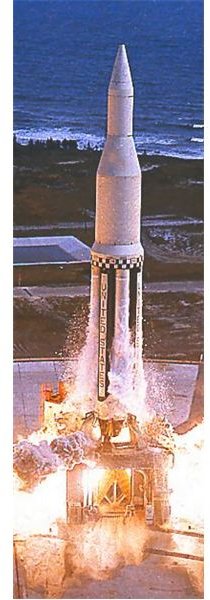This Day in Astronomy and Aerospace History: October 27
This Day in Astronomy and Aerospace History
1958
The United States Congress established a special committee on Life Sciences at Langley in order to determine what would qualify personnel to enter the Mercury program and become the first American astronauts.
1961
NASA launched the first dedicated “space launcher” (a first stage booster), with the designation “Saturn I” on its first test flight, which was designated “Mission Saturn-Apollo 1” from on first test flight from Atlantic Missile Range. With eight engines capable of delivering nearly 1.3 million pounds of thrust, the Saturn I was the largest rocket in history. During the course of its test flight, it carried its water-filled mock-upper stage to an altitudes of 84.8 miles before coming to rest 214.7 miles down range of its launch position. Following the successful test, NASA Administrator James E. Webb spoke with the press, saying “The flight today was a splendid demonstration of the strength of our national space program and an important milestone in the buildup of our national capacity to launch heavy payloads necessary to carry out the program projected by President Kennedy on May 25.” The test was enormous step forward in what would later be dubbed “the space race” between the U.S. and the Soviet Union.
1967
The Soviet Union launched the Cosmos 186 space craft on a mission to rendezvous from with Cosmos 188 to perform what would be the first fully automated space docking in history on October 30th.
1968
The Soviet space craft Soyuz 3, launched the day prior, failed to dock with the Soyuz 2 as planned over three successive attempts. The Soviets would publicly blame the failure on cosmonaut Georgi Beregovoi’s piloting of the Soyuz 3, however, it would later be revealed the the Soyuz 2 45K star sensor had malfunctioned during the flight, preventing the craft from being positioned by its computer. The failure to dock on the first manned mission following the incident in which cosmonaut Vladimir Komarov had died landing the Soyuz 1 marks the loss of the U.S.S.R.’s lead in the space race. Less than a year later, U.S. astronauts would walk on the Moon, and the Soviet space program would descend into disgrace as malfunctions and mission failures accumulated.
1998
The Znamya 2.5 space mirror is deployed from Progress M-40 Russian space freighter. It failed to deploy properly and burned up in the atmosphere on February 5, 1999 along with the expendable Progress ship. The Znamya project was an attempt to direct additional solar power to Earth using a series of experimental orbital mirrors. Following the failure of 2.5, however, the project was abandoned.
1999
Asteroid 3838 Epona passes within 0.374 AU of Earth.
